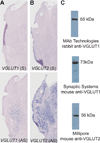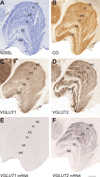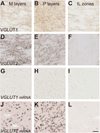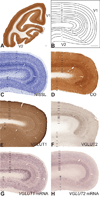Differential expression of vesicular glutamate transporters 1 and 2 may identify distinct modes of glutamatergic transmission in the macaque visual system
- PMID: 23524295
- PMCID: PMC3695749
- DOI: 10.1016/j.jchemneu.2013.02.007
Differential expression of vesicular glutamate transporters 1 and 2 may identify distinct modes of glutamatergic transmission in the macaque visual system
Abstract
Glutamate is the primary neurotransmitter utilized by the mammalian visual system for excitatory neurotransmission. The sequestration of glutamate into synaptic vesicles, and the subsequent transport of filled vesicles to the presynaptic terminal membrane, is regulated by a family of proteins known as vesicular glutamate transporters (VGLUTs). Two VGLUT proteins, VGLUT1 and VGLUT2, characterize distinct sets of glutamatergic projections between visual structures in rodents and prosimian primates, yet little is known about their distributions in the visual system of anthropoid primates. We have examined the mRNA and protein expression patterns of VGLUT1 and VGLUT2 in the visual system of macaque monkeys, an Old World anthropoid primate, in order to determine their relative distributions in the superior colliculus, lateral geniculate nucleus, pulvinar complex, V1 and V2. Distinct expression patterns for both VGLUT1 and VGLUT2 identified architectonic boundaries in all structures, as well as anatomical subdivisions of the superior colliculus, pulvinar complex, and V1. These results suggest that VGLUT1 and VGLUT2 clearly identify regions of glutamatergic input in visual structures, and may identify common architectonic features of visual areas and nuclei across the primate radiation. Additionally, we find that VGLUT1 and VGLUT2 characterize distinct subsets of glutamatergic projections in the macaque visual system; VGLUT2 predominates in driving or feedforward projections from lower order to higher order visual structures while VGLUT1 predominates in modulatory or feedback projections from higher order to lower order visual structures. The distribution of these two proteins suggests that VGLUT1 and VGLUT2 may identify class 1 and class 2 type glutamatergic projections within the primate visual system (Sherman and Guillery, 2006).
Copyright © 2013 Elsevier B.V. All rights reserved.
Figures











References
-
- Adams MM, Hof PR, Gattass R, et al. Visual cortical projections and chemoarchitecture of macaque monkey pulvinar. J Comp Neurol. 2000;419:377–393. - PubMed
-
- Aihara Y, Mashima H, Onda H, et al. Molecular cloning of a novel brain-type Na+-dependent inorganic phosphate cotransporter. J Neurochem. 2000;74:2622–2625. - PubMed
MeSH terms
Substances
Grants and funding
LinkOut - more resources
Full Text Sources
Other Literature Sources

